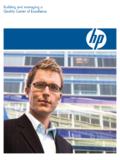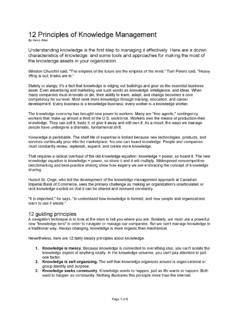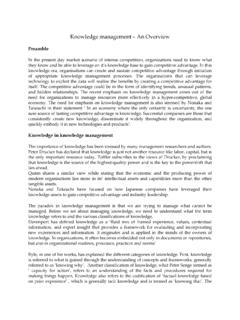Transcription of Integrating the triple bottom line into an …
1 ByErnst & Young LLP Craig Faris | Brian Gilbert | Brendan LeBlancMiami University Brian Ballou | Dan L. Heitger Integrating the triple bottom line intoan enterprise risk management programThe information contained herein is of a general nature and based on authorities that are subject to change. Applicability of the information to specific situations should be determined through consultation with your professional adviser, and this paper should not be considered substitute for the services of such advisors, nor should it be used as a basis for any decision or action that may affect your of Sponsoring Organizations of the Treadway CommissionThought Leadership in ERMA uthorsErnst & Young LLPP rincipal Contributors Craig Faris Pricipal, Ernst & Young LLP Brian Gilbert Executive Director, Ernst & Young LLP Brendan LeBlanc Executive Director.
2 Ernst & Young LLP Miami University Principal Contributors Brian Ballou Professor, Miami University Dan L. Heitger Professor, Miami University This project was commissioned by the Committee of Sponsoring Organizations of the Treadway Commission (COSO), which is dedicated to providing thought leadership through the development of comprehensive frameworks and guidance on enterprise risk management, internal control, and fraud deterrence designed to improve organizational performance and governance and to reduce the extent of fraud in is a private-sector initiative jointly sponsored and funded by the following organizations.
3 American Accounting Association (AAA) American Institute of CPAs (AICPA) Financial Executives International (FEI) The Institute of Management Accountants (IMA) The Institute of Internal Auditors (IIA)Committee of Sponsoring Organizationsof the Treadway Board MembersDavid L. LandsittelCOSO ChairDouglas F. PrawittAmerican Accounting AssociationRichard F. ChambersThe Institute of Internal AuditorsMarie N. HolleinFinancial Executives InternationalCharles E. LandesAmerican Institute of CPAs (AICPA)Sandra RichtermeyerInstitute of Management AccountantsThought Leadership in ERMC ommittee of Sponsoring Organizations of the Treadway CommissionMay 2013 Research Commissioned byResearch Commissioned byCopyright 2013, The Committee of Sponsoring Organizations of the Treadway Commission (COSO).
4 1234567890 PIP 198765432 All Rights Reserved. No part of this publication may be reproduced, redistributed, transmitted or displayed in any form or by any means without written permission. For information regarding licensing and reprint permissions please contact the American Institute of Certified Public Accountants licensing and permissions agent for COSO copyrighted all inquiries to or AICPA, Attn: Manager, Rights and Permissions, 220 Leigh Farm Rd., Durham, NC 27707. Telephone inquiries may be directed to Leadership in ERM | Demystifying Sustainability Risk | iiiSustainability s Evolving Role in Business 1 Applying a Sustainability Lens toCOSO s Objectives Categories 3 Integrating Sustainability Into theComponents of the COSO ERM Framework 7 Seven Tips for Raising SustainabilityAwareness in the Organization 10 Conclusion: Managing Risk for a Sustainable Future 11 About COSO 12 About the Authors 12 Contents Leadership in ERM | Demystifying Sustainability Risk | world has changed.
5 In today s highly competitive markets and volatile economic environments, no organization, especially those that rely on limited or declining natural resources, can operate the way they did a decade ago. Consumers are more sophisticated, driven, in part, by the wider availability of information, increased visibility into corporate business practices and a better understanding of the interconnectedness of all that we do. The pressure to succeed is enormous. More importantly, the pressure to succeed in a manner that supports sustainability principlesis rapidly growing.
6 Intangibles identify an organization s true valueThe confluence of risks and opportunities associated with environmental, social and economic performance has made sustainability a strategic priority for companies as part of their overall business strategy. Measuring an organization s environmental, social and economic performance is often referred to as the triple bottom line . Ocean Tomo s 2010 Intangible Asset Market Value report suggests that only 20% of an S&P 500 company s market value can be explained by its physical and financial assets. This is down from 83% in The remainder comprises intangible factors, such as intellectual capital, human capital, brand and reputation, and relationships with regulatory bodies, non-governmental organizations, customers, suppliers and other external stakeholders.
7 Sustainability s Evolving Role in Business1 Ocean Tomo, Intangible Asset Market Value 2010, 2011, World Commission on Environment and Development (WCED), Our Common Future, Oxford: Oxford University Press, 1987, p. is no longer one function s domain. It s a responsibility that everyone needs to SustainabilitySustainability can be described in a number of ways. The most cited definition originates from Our Common Future, known also as the Brundtland Report. Sustainable development is development that meets the needs of the present without compromising the ability of future generations to meet their own needs.
8 2 Within the context of this article, we will use the term sustainability synonymously with corporate social responsibility, corporate citizenship, stewardship and corporate responsibility. The scope of this paper does not afford us the opportunity to explore the concepts of the six capitals, value creation, integrated thinking, planetary limits and sustainable outcomes distributed by the International Integrated Reporting Council (IIRC). However, we do lay the foundation for incorporating sustainability-related risks into an existing Enterprise Risk Management (ERM) Energy-fuel, oil, alternative Water Greenhouse gases Emissions Waste reduction: medical; hazardous; non-hazardous.
9 Construction Recycling Reprocessing/re-use Green cleaning Agriculture/organic foods Packaging Product content BiodiversityEconomic Accountability/transparency Corporate governance Stakeholder value Economic performance Financial objectivesSocial Public policy and advocacy Community investments Working conditions Health/nutrition Diversity Human rights Socially responsible investing Anticorruption and bribery Safety2 | Demystifying Sustainability Risk | Thought Leadership in ERM3 Flammer, Caroline, MIT Sloan School of Management, 18 July 2011, board member hearing this analysis should be asking two key questions:1.
10 What does our specific market value profile look like?2. Do we have strategies, processes and approaches to effectively manage that profile?Sustainability s corporate evolutionFor many organizations, sustainability has evolved from a feel good exercise to a strategic imperative that focuses on economic, environmental and social risks and opportunities which, left unattended, can potentially threaten the long-term success of strategies and the viability of business models. They understand that sustainability is not one function s domain, but rather a responsibility that the entire enterprise needs to own.

















